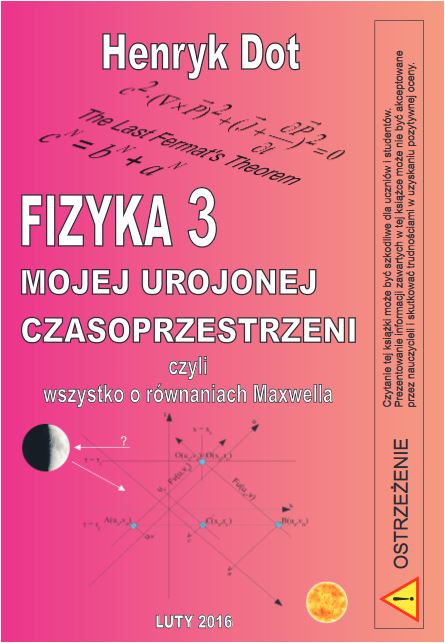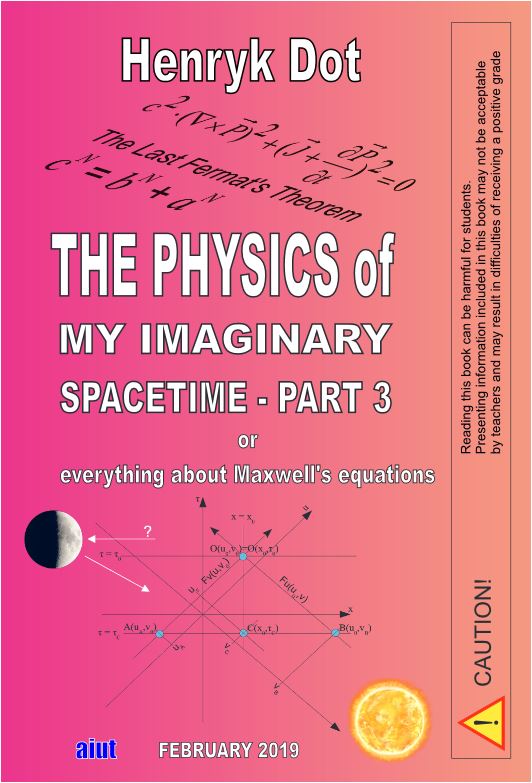★ HenrykDot.com
★
is the online companion to a series of books published by AIUT under the common main title
"Physics of My Imaginary Space-Time" by Henryk Dot.
is the online companion to a series of books published by AIUT under the common main title
"Physics of My Imaginary Space-Time" by Henryk Dot.
Physics 3 - Return
Return to Physics 3
Physics 4 -
Home
Introduction
Physics 4 - Chapter 1
Motion
Orbital motion
Return to Physics 3
Physics 4 -
Home
Introduction
Physics 4 - Chapter 1
Motion
Orbital motion
Contact
email: henryk.dot(at)aiut.com
"Subject" should begin with
a digit corresponding to the day
of the week., e.g. Sunday=7
"Subject" should begin with
a digit corresponding to the day
of the week., e.g. Sunday=7
Books published by AIUT
are found in libraries according to the list of compulsory copies.
Second Edition of "Fizyka 3"
ISBN 978-83-926856-1-6

can be bought in Warsaw
in the Academic Bookstore
PW Publishing House
Noakowskiego street 18/20
and in Katowice
in the bookstore "Liber"
Bankowa street 11.
(area of Silesian University)
English edition of "Physics"
ISBN 978-83-926856-2-3

is also in libraries
and the distribution method should be asked wydawca@aiut.com.
|
Chapter 1. Basic concepts describing motion 1. Motion - general equations
In general "
" will be used as a time variable,
as a position vector | |
| Speed | (1.1) |
| and | |
| acceleration . | (1.2) |
| Equation (1.2) can be also presented as | |
| - vector | (1.3) |
| And after multiplying respective sides of (1.1) and (1.3) we obtain: | |
| - scalar . | (1.4) | We can integrate formula (1.4), each side independently - right side along the trajectory from the initial position to the final position and the left side from the initial speed to the final speed which results in: |
| . | (1.5) |
| We can multiply both sides of this equation by any value. If it just happens that this value is a mass and if we denote as a product of thus , we can see that we obtained a known relationship between kinetic energy and work: | |
| . | (1.6) |
|
Please note that equation (1.5) represents general relationship and that means that any object (for example a mass ) at initial speed , accelerated at at the distance of will reach final speed . | |
|
NOTE: For the purpose of this discussion, 2-nd Newtonian law is applied purely as a mathematical expression of the product: by . Similarly, integrating (1.3) in respect to and results in: | |
| (1.7) | |
| As already mentioned above, this relationship (1.7) applies to any object. Should this object be a mass , then multiplying both sides by , we just obtained relationship between momentum and driving force. | |
| . | (1.8) |
|
We derived relationships, both (1.6) and (1.8) from definitions
of speed and acceleration (1.1) and (1.2), and from relationship between force,
mass and acceleration. We have not introduced (defined) such terms as work, energy,
and momentum, we just applied these names to expressions which appeared in. We will try to derive other relationships (motion laws) without using terms of work and energy. Why are we doing this? Well, most of the textbooks begin explanations regarding motion and mechanics by introducing terms of work and energy, and laws which rule them, while these terms and laws directly result from definitions (1.1) and (1.2). To derive energy conservation law, the equation (1.5) is written separately times for each object (mass) (indexed by "" ), and then individual equations are summed respectively by their sides. | |
| . | (1.9) |
| In other words - apart from the concept of mass,
can be treated as coefficients of the linear combination of all equations that make up (1.9). If on the right side the interaction between all pairs is balanced, that is: | |
| , | (1.10) |
| then the equation (1.9) can be written as: | |
| . | (1.11) |
| which is the same as following: | |
| (1.12) | |
| This means that the sum of kinetic energies of separated group of objects
is constant. To obtain the law of momentum conservation, equation (1.8) should be written for each object separately and, similarly as before, summed up respectively by sides | |
| . | (1.13) |
| If on the right side the sum of forces equals zero, | |
| (1.14) | |
| then | |
| (1.15) | |
| and finally | |
| , | (1.16) |
| thus, momentum remains constant. It is worth noting an interesting relationship in equation (1.5) – assuming that acceleration would be a function of a position as per formula , where – constant, and motion would occur from initial speed and initial position to final speed and final position . In this case: | |
| . | (1.17) |
| This would be a speed of the object at the position
(as measured from the central point), which is approaching from infinity to central point. After multiplying this equation by mass , this equation also represents a kinetic energy required to leave a potential field such as in given expression. | |
© 2020 Henryk Dot -
